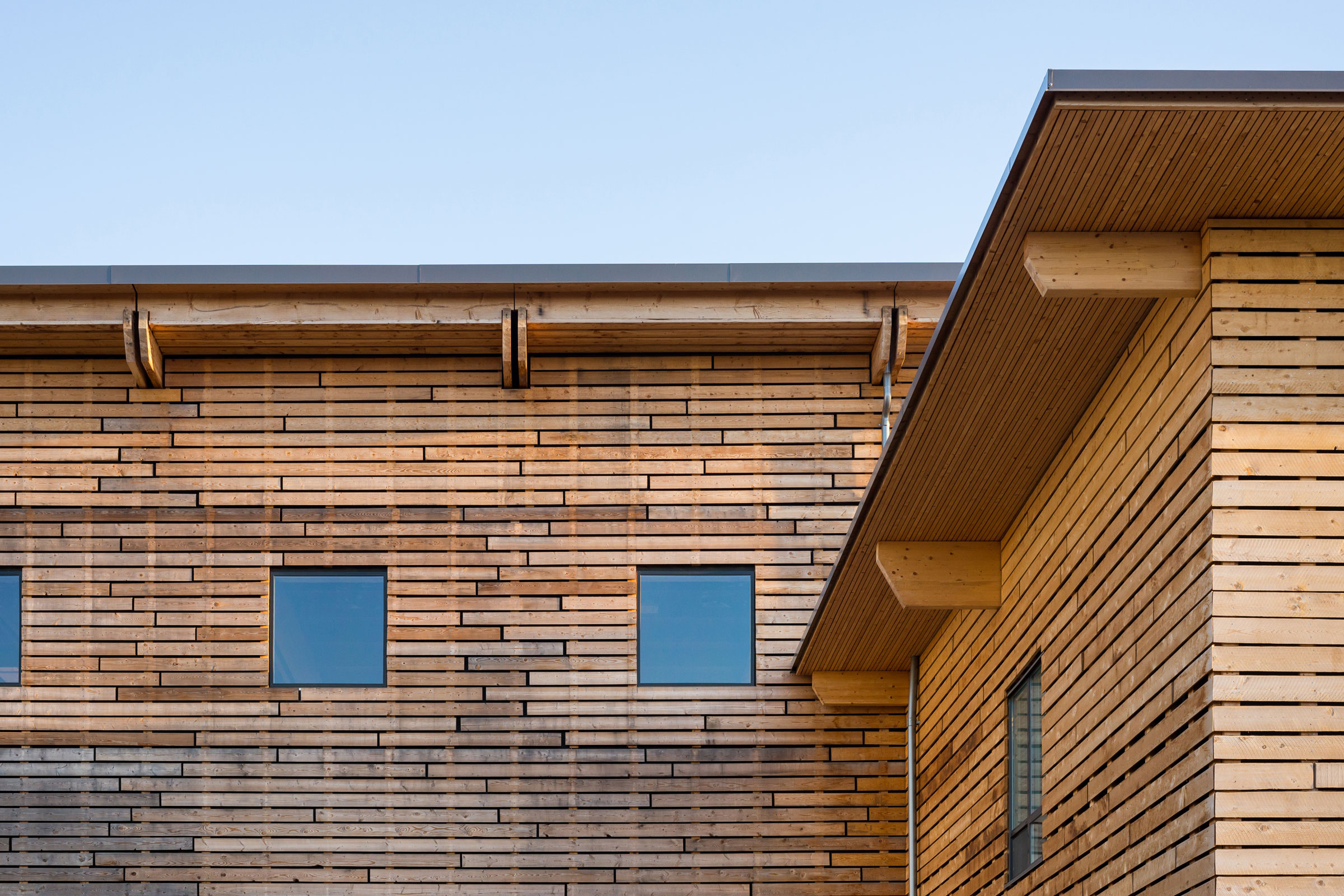Story at a glance:
- Hardwoods are often used for flooring for their durability and low maintenance.
- Resilient Douglas fir is a popular softwood used in timber frame construction.
- Western red cedar is loved for its flexibility in design as well as its acoustic properties.
Wood has long been one of the most widely used sustainable building materials in the world. What type of wood a builder or architect may choose often depends on the project.
Wood for construction varies widely from hardwoods like oak or walnut—often used for floors, walls, and ceilings, and floors—to softwoods like cedar or fir—more commonly seen used for things like doors and furniture. Western red cedar is one of the lightest commercial softwoods and popular both for its lightweight properties and its aesthetic benefits.
Here we explore some of the most popular types of wood for construction.
Common Types of Hardwoods
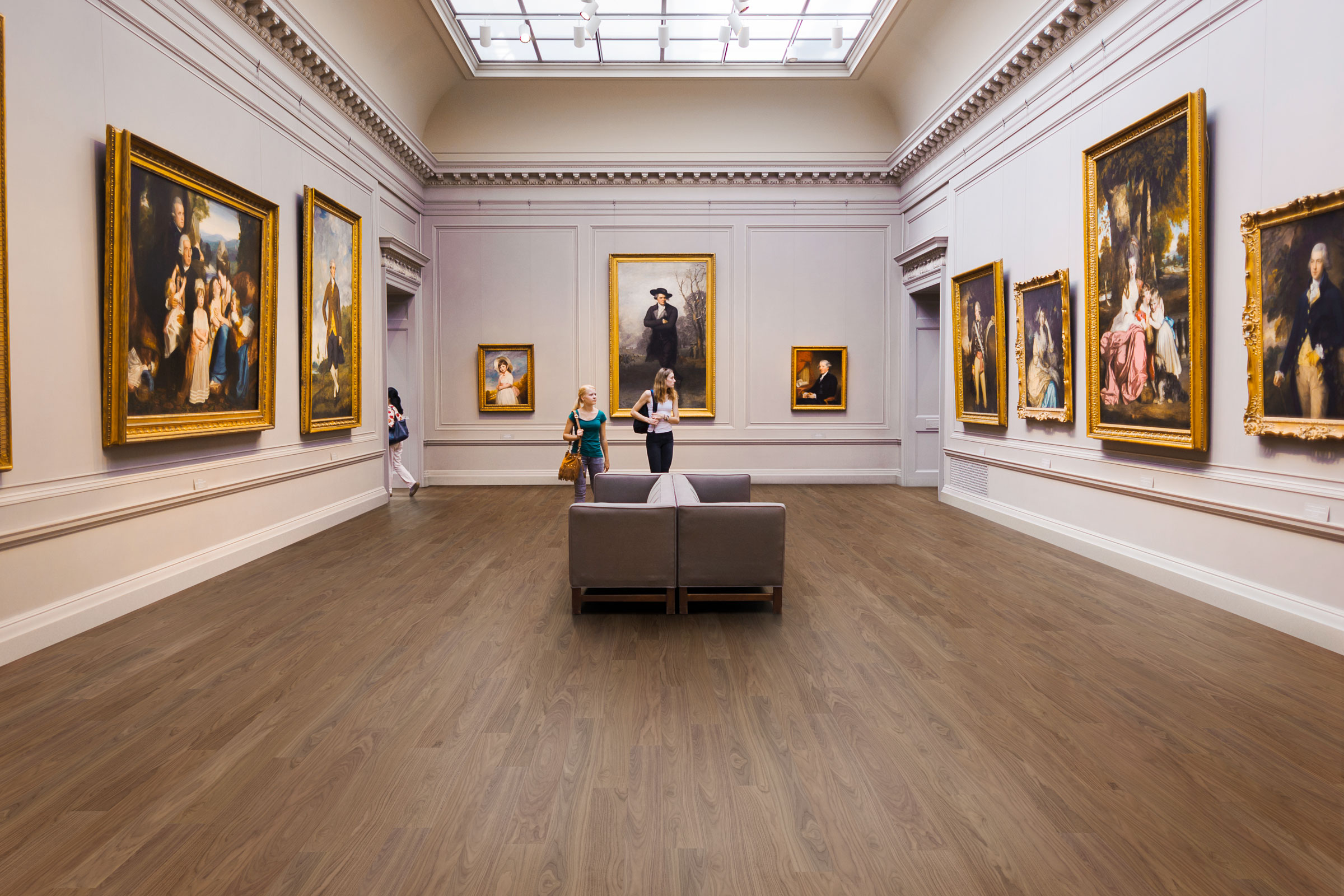
Hardwoods are a category of tree species that have broad leaves and seeds enclosed within true flowers. Hardwoods are commonly used within the AEC industry for things like flooring, furniture, decking, and more. Natural walnut floor from Kährs’ Life Collection is pictured above. Photo courtesy of Kährs
Botanically speaking, hardwoods are a category of tree species known as angiosperms that are characterized as having broad leaves and seeds enclosed within true flowers.
Some of the most common types of hardwood include, but are not limited to:
Ash
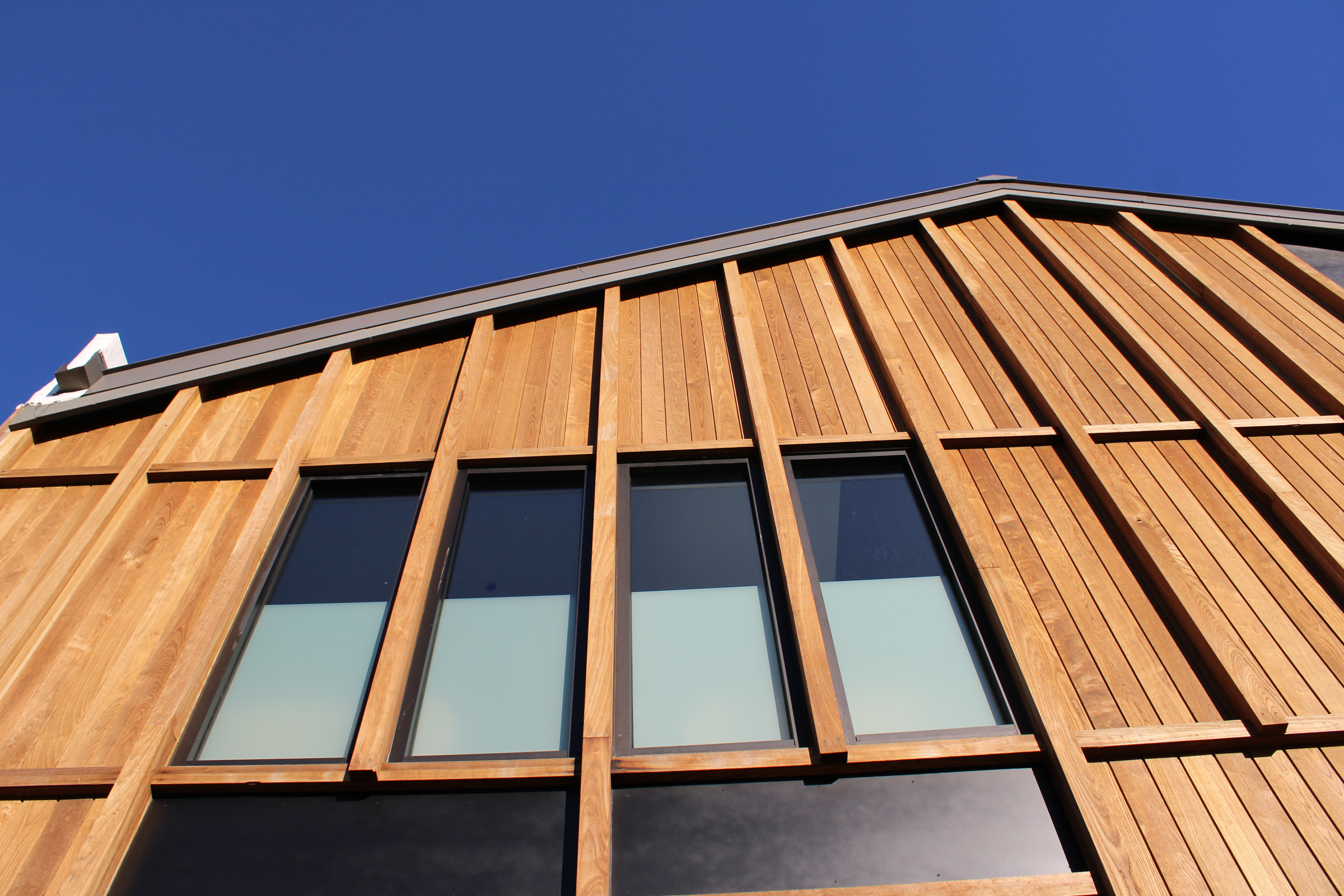
Though typically used for furniture and other interior applications, ash wood can be used outdoors as long as it has been thermally-modified. Photo courtesy of Tantimber
Ash is a strong and dense straight-grained wood typically used for interior applications like molding, timber frames, staircases, and treads. Because ash is able to take staining, polishing, and gluing well, it is an extremely popular choice for woodworking purposes and is often used in furniture-making.
Ash is also one of several species commonly used for thermally-modified wood products. “It doesn’t warp, swell, or shrink,” Mehmet Zenginler, co-founder and managing partner of G Wood Pro—the exclusive distributor of Tantimber ThermoWood products in the US—previously told gb&d. “Even in extreme weather conditions or when used in different applications, like for saunas or docks on the ocean, it’ll keep its stability.”
Untreated or unmodified ash lumber, however, is not suitable for outdoor use and does not fare well when kept in contact with the outside ground.
Beech
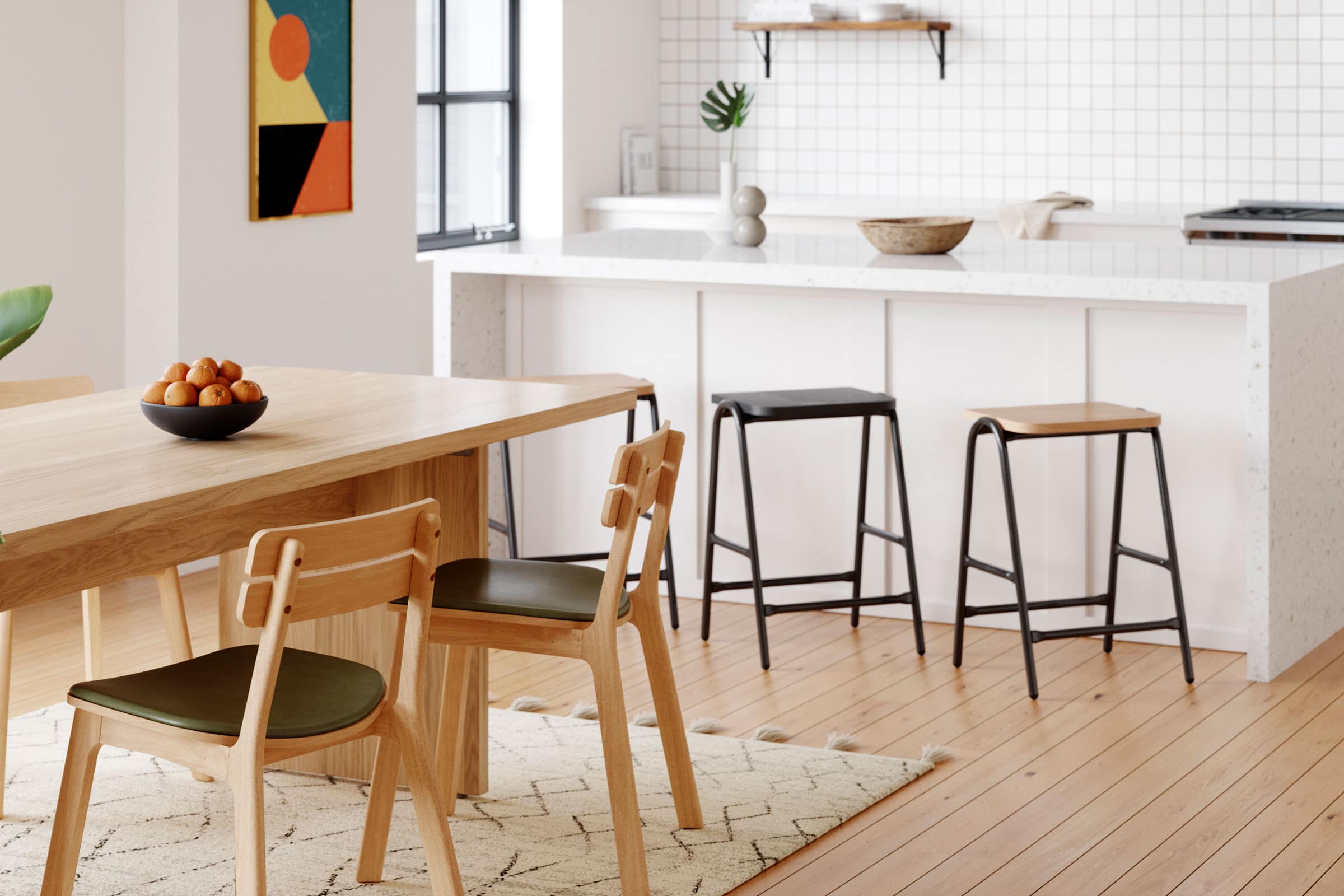
The Brooke Chair (left) from Only Good Things features a beech wood frame. Photo courtesy of Only Good Things
Found throughout eastern North America, beech is a pale, cream-colored wood that boasts a high density, average hardness, and good machinability. Beech’s durability and ease of which it takes water-based finishes make it a common choice for furniture and cabinetry.
Thanks to beech wood’s straight grain, even texture, and high strength, it can be also used for a variety of building elements that require ample pressure resistance, such as flooring, framing systems, and load-bearing beams. Beech can also be used to construct glulam elements and is commonly used in conjunction with spruce in the manufacture of hybrid glulam beams.
In its natural state, however, beech isn’t particularly water resistant and so is not suitable for outdoor use or in areas that are frequently moist or damp.
Oak
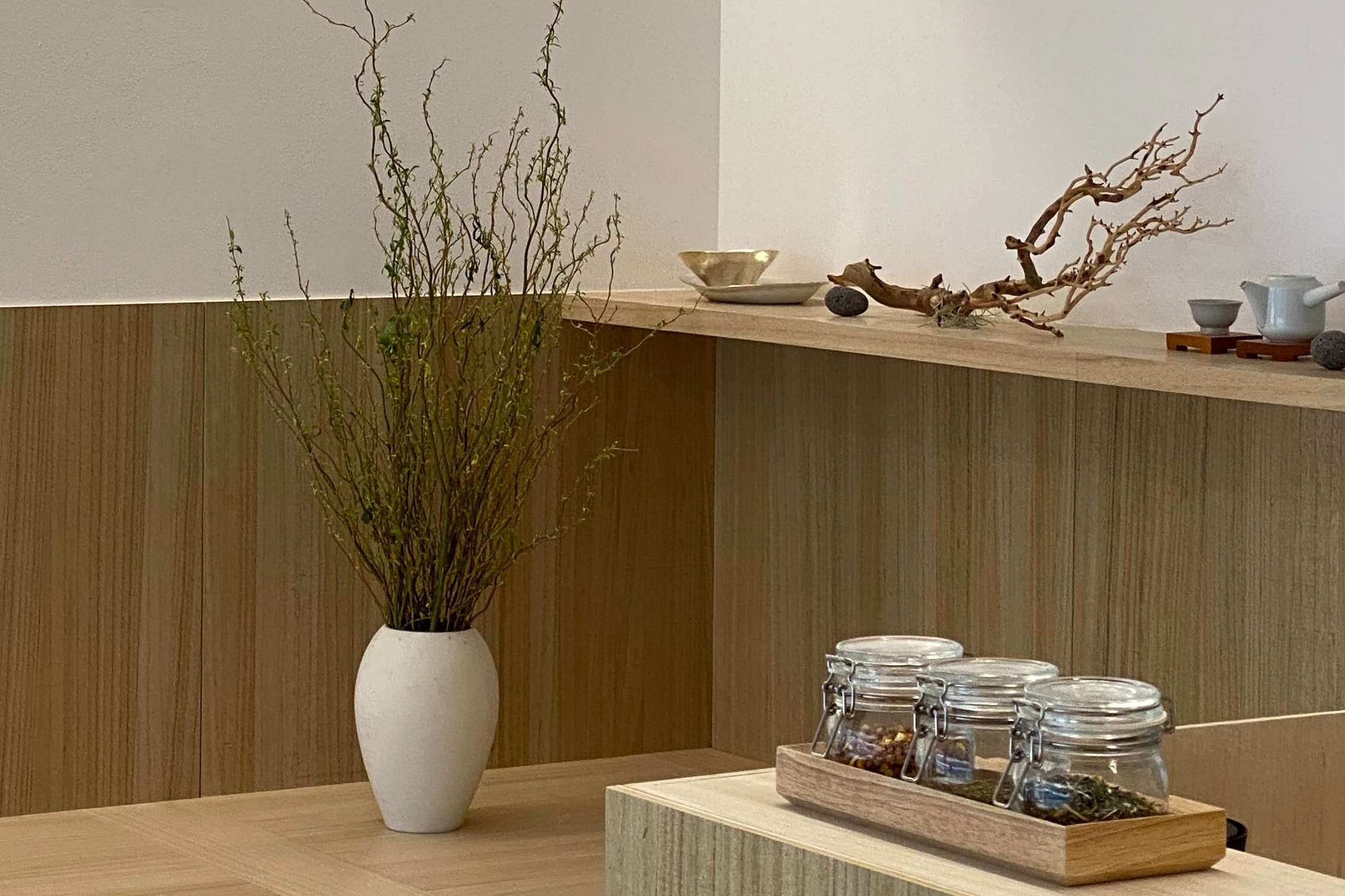
Cabinets in rift white oak. Flooring in plain sliced white oak. Photo by Yoonji Kim
Oak is loved for everything from flooring and cabinetry to furniture. White oak has some water resistance, so it’s also been a choice for things like boats. Oak is durable and resists damage from insects. You’ll often find oak used in engineered wood flooring, too.
Delta Millworks is among the many manufacturers reinventing oak. Their exterior woods include the new thermally modified Mojave collection—available in oak, hemlock, radiata, and Ponderosa pine.
Delta’s Kebony, Accoya, thermally modified oak, and thermally modified radiata pine are also great choices for decks, according to Delta CEO Robbie Davis. He says these sustainable products typically don’t need to be treated with anything to maintain their structural performance during an extended life cycle, which saves clients money in the long run and allows them to show off the naturally aged wood.
Maple

The kitchen table is locally crafted using reclaimed maple. All of the appliances are Energy Star–certified with the lowest energy use possible. Photo by Krista Jahnke Photography
Maple is one of the most common commercially available woods in the US and is among the highest densities when it comes to durable American hardwoods. It’s also typically moderate in price.
Because maple has less grain than other types of wood, it is often used in luxury furniture, flooring, and cabinetry to ensure a clean, smooth appearance. Medley—a California-based furniture company—for example, handcrafts all of their products using either maple or walnut sourced from FSC-certified forests.
Walnut
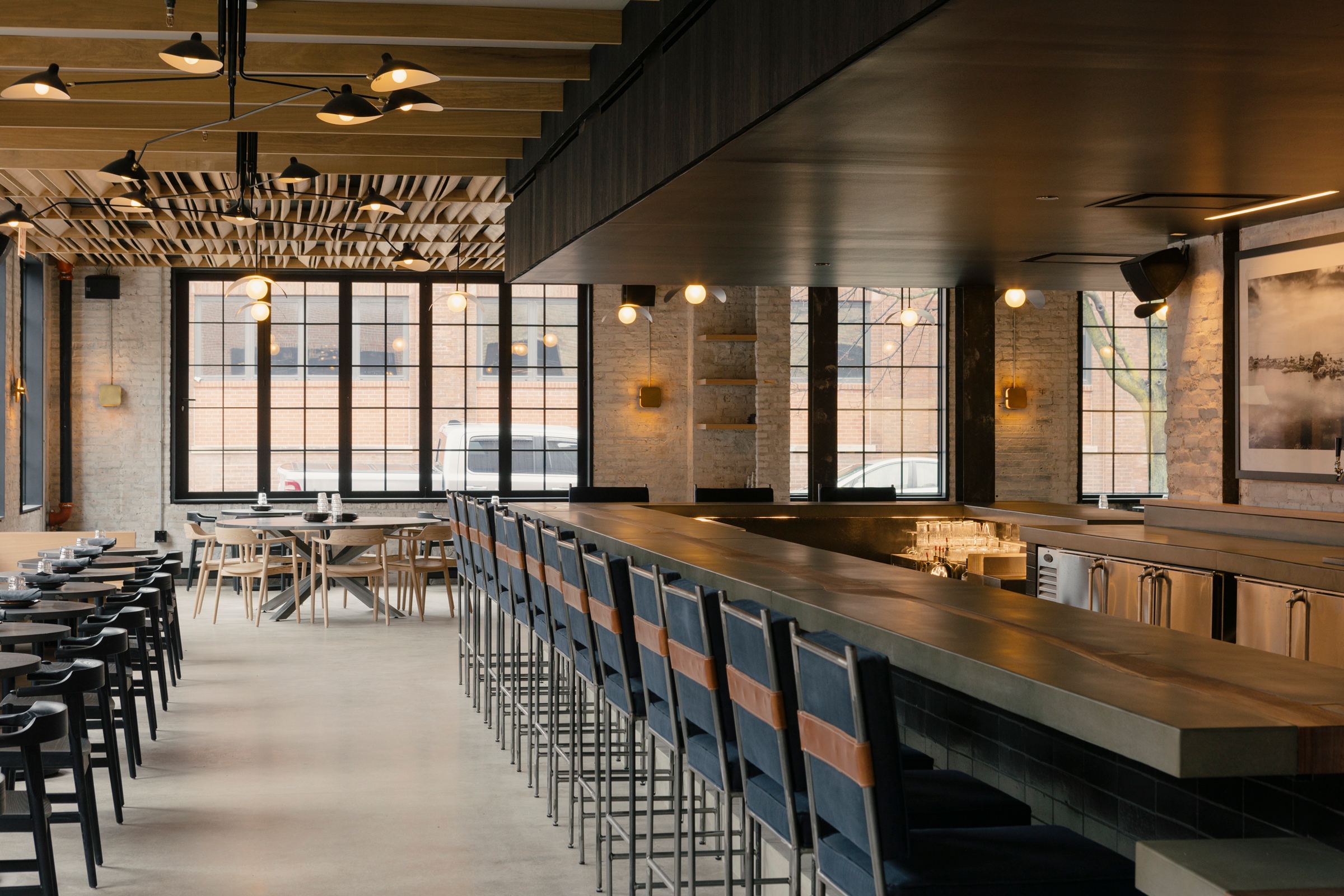
The bar top at Maxwells Trading features concrete and wood, using reclaimed live edge walnut slabs and burying the live edge with concrete. Photo by Jeff Marini
Walnut is often used because it’s easy to cut, shape, and sand, according to Woodworkers Source. It has a fine yet open grain with distinct patterns and a color architects love. Walnut is commonly used for everything from furniture and cabinets to flooring and paneling.
When designing Maxwells Trading—a high-end, sustainable restaurant in Chicago—WDA Design and Meg McMorrow Design chose to install a concrete-and-wood bar top that features reclaimed live-edge walnut slabs. The bar top showcases the wood’s fine, straight grain and perfectly demonstrates the subtle elegance finished walnut can bring to a space.
Cherry
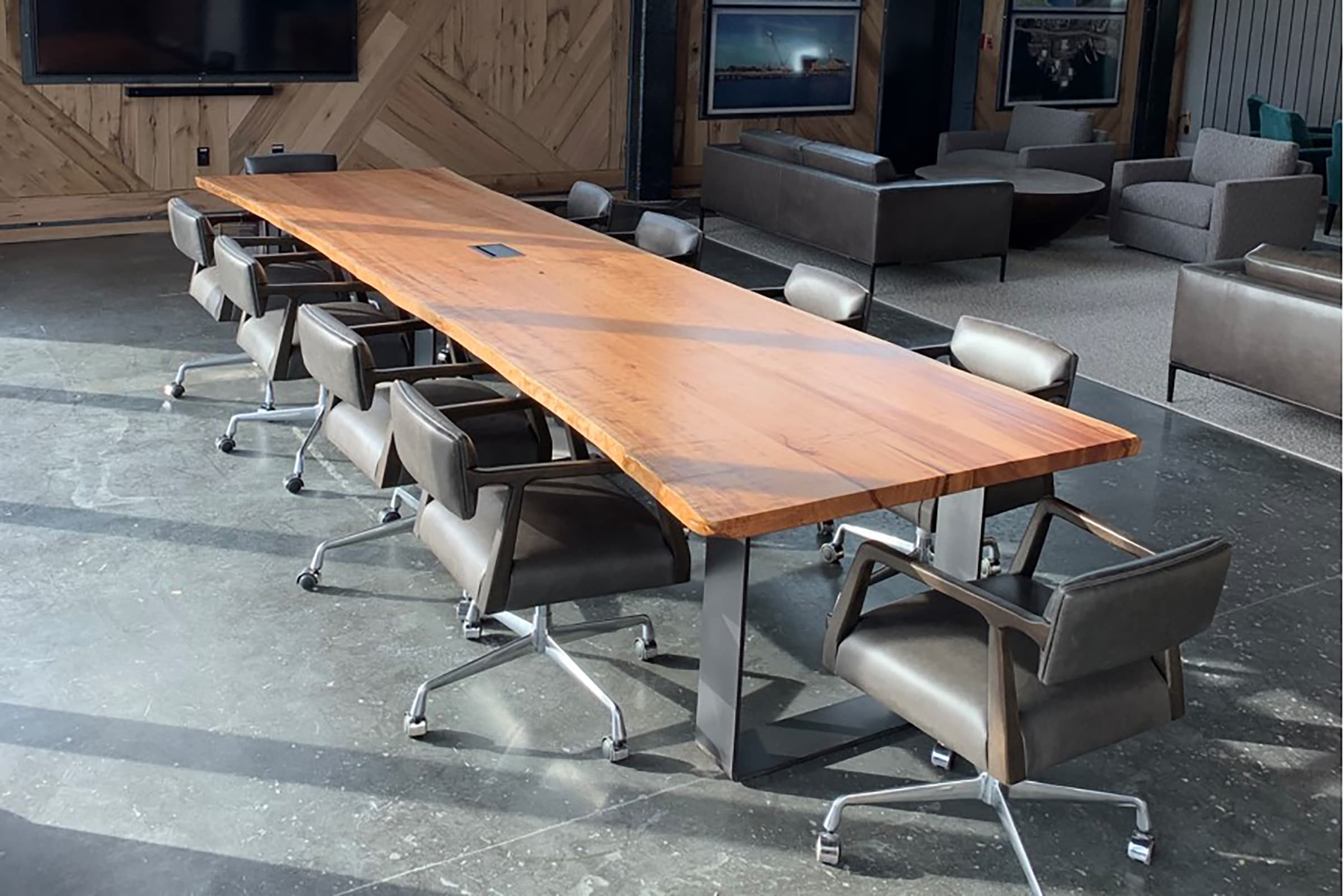
Sandtown Furniture crafted this conference table from a slab of reclaimed black cherry. Photo courtesy of Sandtown Furniture
Cherry is one of the most popular domestic hardwoods in the US and is loved for its workability, according to Family Handyman. Cherry wood appears as a light pink when freshly cut and gradually darkens to a rich brown or deep red over time, making it an excellent choice for furniture, flooring, millwork, casework, and other decorative elements. Cherry should not be used outdoors, as it is extremely prone to insect and moisture damage.
In terms of density, cherry is fairly middle-of-the-road for hardwoods, meaning it has good bending properties and low stiffness. Cherry wood is not as strong as some other hardwoods, but is still considered durable and will stand the tests of time if properly cared for. TimberHomes in Vermont uses Black Cherry in many of its projects both for its strength and its beautiful red color.
Birch
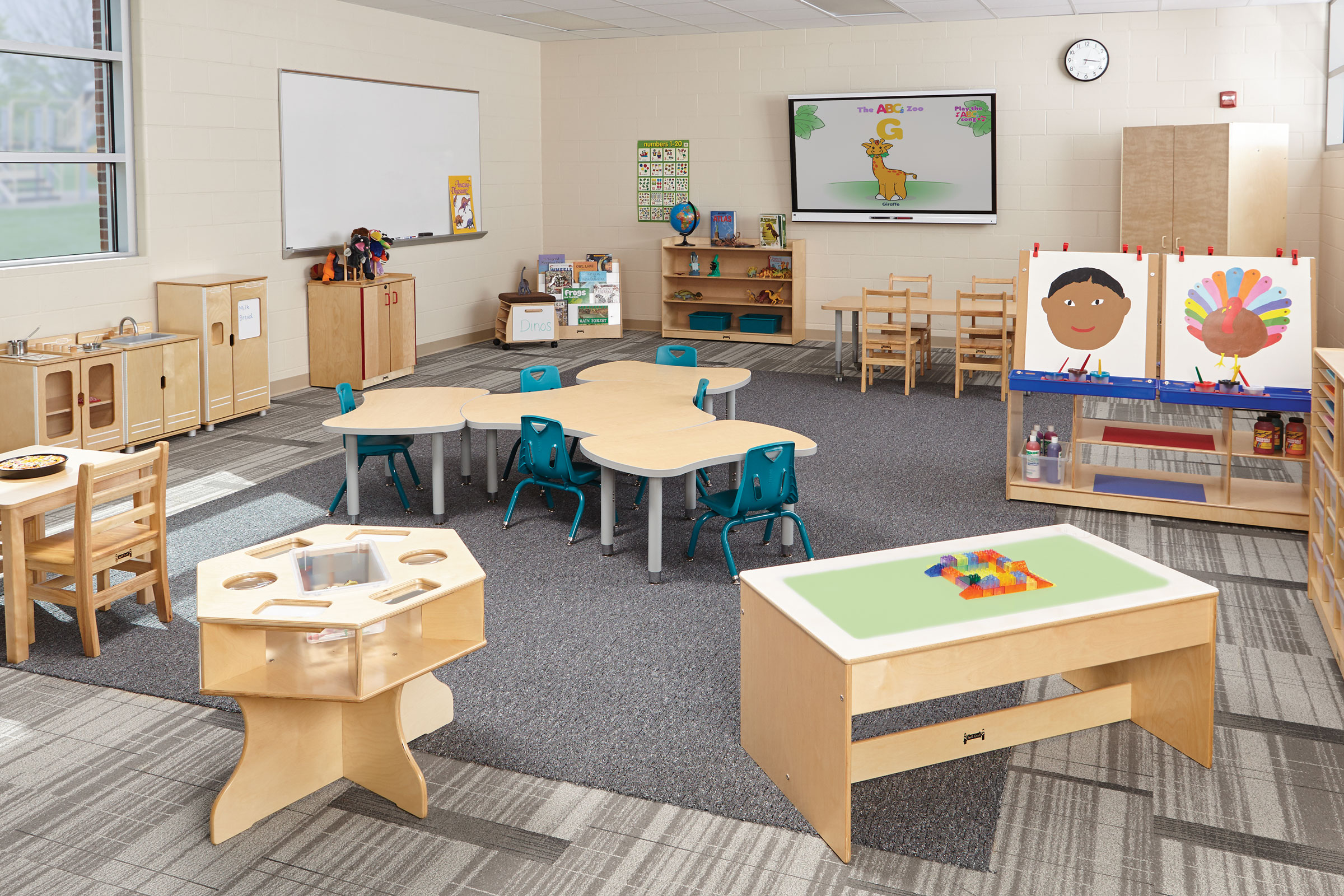
Jonti-Craft’s expansive collection of educational furniture—from colorful laminate options to sturdy Baltic Birch and modular lines—means there is an option for every learning space. Photo courtesy of Jonti-Craft
Typically boasting a straight or slightly wavy grain and an even texture, birch is characterized by the American Hardwood Information Center as a hard, strong wood that has good shock resistance and high crushing strength. Birch is rarely used for structural purposes and is mainly used for millwork, casework, paneling, furniture, and flooring.
Like many hardwoods, birch is also commonly used to manufacture plywood. Birch plywood uses multiple sheets of birch veneer and is one of the strongest, most stable types of plywood in the industry. Birch plywood is so durable, in fact, that Jonti-Craft—the world’s leading manufacturer of children’s furniture—carries an entire line of furniture made from Baltic Birch, a variety of birch plywood sourced from Russia, Finland, and nearby Baltic states.
Birch has a naturally low resistance to rot, decay, and insect infestation, meaning it is not recommended for outdoor use. The only exception to this is birch plywood that has been treated with a water repellent varnish or some other manner of protective, weather-resistant glazing.
Tulip Poplar
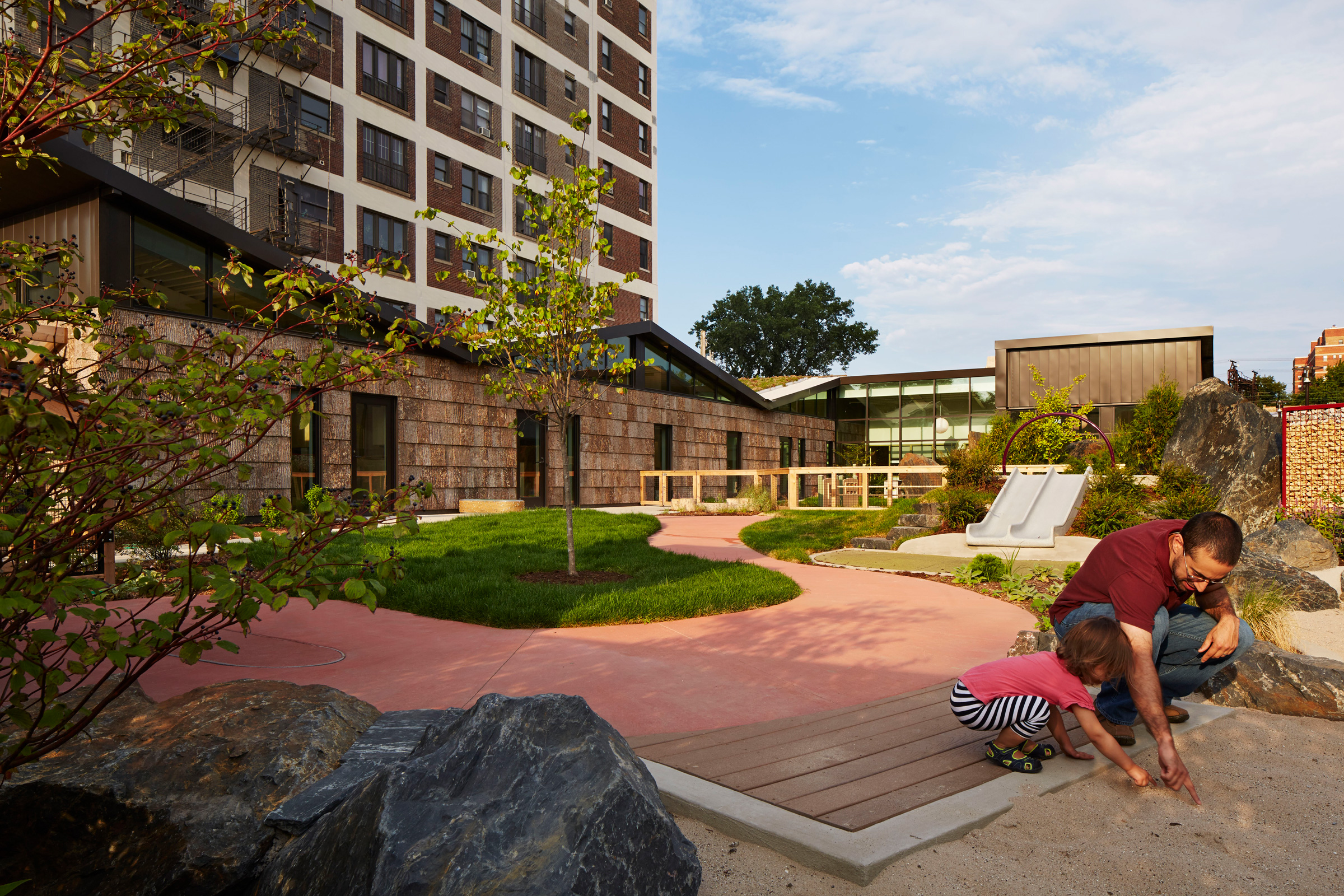
The UChicago Child Development Center is partially clad in poplar bark siding from Highland Craftsmen. Photo by Steve Hall
Tulip poplar—also known as yellow poplar—is a straight-grained, lightweight, and dimensionally-stable hardwood often used for construction plywood and construction grade lumber in sheds and smaller homes. Ranging in color from creamy yellow to light brown, poplar is relatively soft and easy to work by hand or machine. It is commonly used to fashion furniture, casework, millwork, and house trim.
Builders Surplus also notes its medium density, which allows paints, finishes, and glues to easily adhere, making it a top contender in the world of hardwoods.
Beyond the wood itself, the bark of poplar trees can also be used for construction purposes. North Carolina-based finishing materials supplier Highland Craftsmen, for example, offers a Poplar Bark House® siding. The richly-textured shingle siding is made of bark stripped from yellow poplar trees before they are shipped to sawmills for use in other products. Poplar Bark House siding can be found lining both the interior and exterior of the UChicago Child Development Center.
Common Types of Softwoods
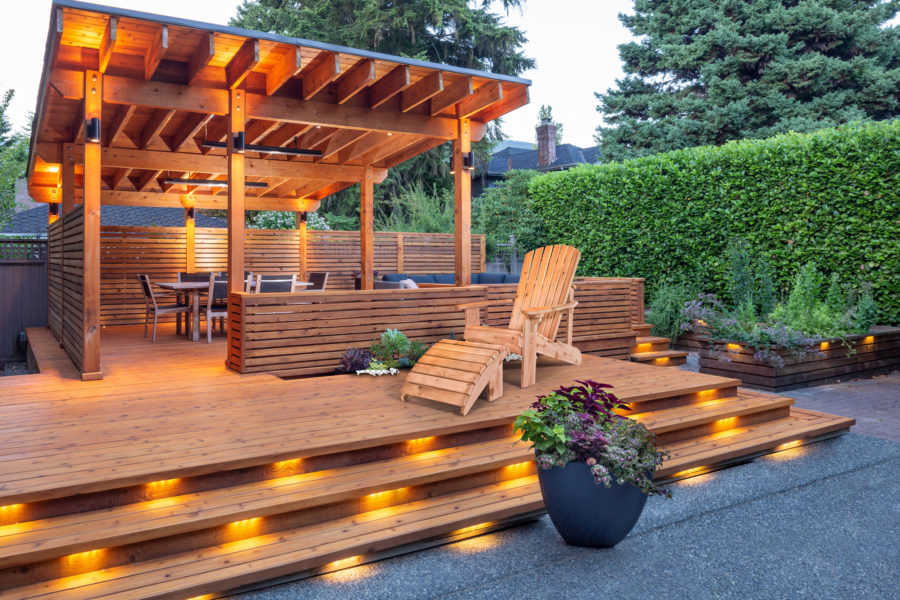
Softwoods are characterized as having needle-shaped foliage and include all cone-bearing trees. This project in British Columbia uses western red cedar, a species of softwood widely used in construction throughout North America. Photo courtesy of Western Red Cedar
Softwoods, on the other hand, are gymnosperms, which means they have naked seeds and needle-shaped foliage instead of the broad leaves found on hardwood trees. Think Wood defines softwoods as those that come from cone-bearing trees.
For wood frame construction of a single-family home, a popular softwood choice is standard SPF, or spruce-pine-fir, lumber. This timber is milled from softwood trees like spruce, fir, and pine—sawn and machine-planed to standard dimensions, according to Eco Home. The wood doesn’t undergo much transformation during processing, has a low embodied energy, and is a renewable resource that stores carbon.
Softwoods include, but are not limited to, the following:
Western Hemlock

9Wood’s panelized linear ceiling system in solid western hemlock is seen throughout Casa Adelante’s lobby, often accompanied by Acousti-Tack’s fabric-wrapped panels with Guilford fabric. Photo by Bruce Damonte
Native to the Pacific coast and northern Rocky Mountains, western hemlock is light reddish brown wood typically used for general construction, plywood, and roofing decks. Western hemlock is non-resinous, meaning it sands and glues easily while also taking stains and finishes well. The wood’s hardness and even density give it a high screw and nail holding ability as well as excellent working properties, allowing it to be fashioned into a variety of products.
And while hemlock is commonly used for exterior applications, it can also be brought indoors. “The basic rule of thumb is if it can be used for exterior, it can always be used for interior. The trend these days is interior ceilings that lead out to either an exterior ceiling or a soffit, and nine times out of 10 we’re using the same wood—usually vertical-grain hemlock,” Robbie Davis, CEO of Delta Millworks, told gb&d in a previous article.
Besides ceilings and soffits, it is not uncommon to find furniture, flooring, moldings, and doors made from western hemlock.
Larch
Thanks to its high percentage of dense heartwood and low percentage of porous sapwood, larch is an extremely durable wood that can be used in a variety of ways. Its high strength allows it to be used for structural applications while its natural resistance to rot and decay makes larch wood suitable for exterior applications like shingles, decking, and siding.
In addition to siding, larch wood is also one of several softwoods commonly used to fashion cross-laminated timber (CLT), a type of mass timber.
Douglas Fir
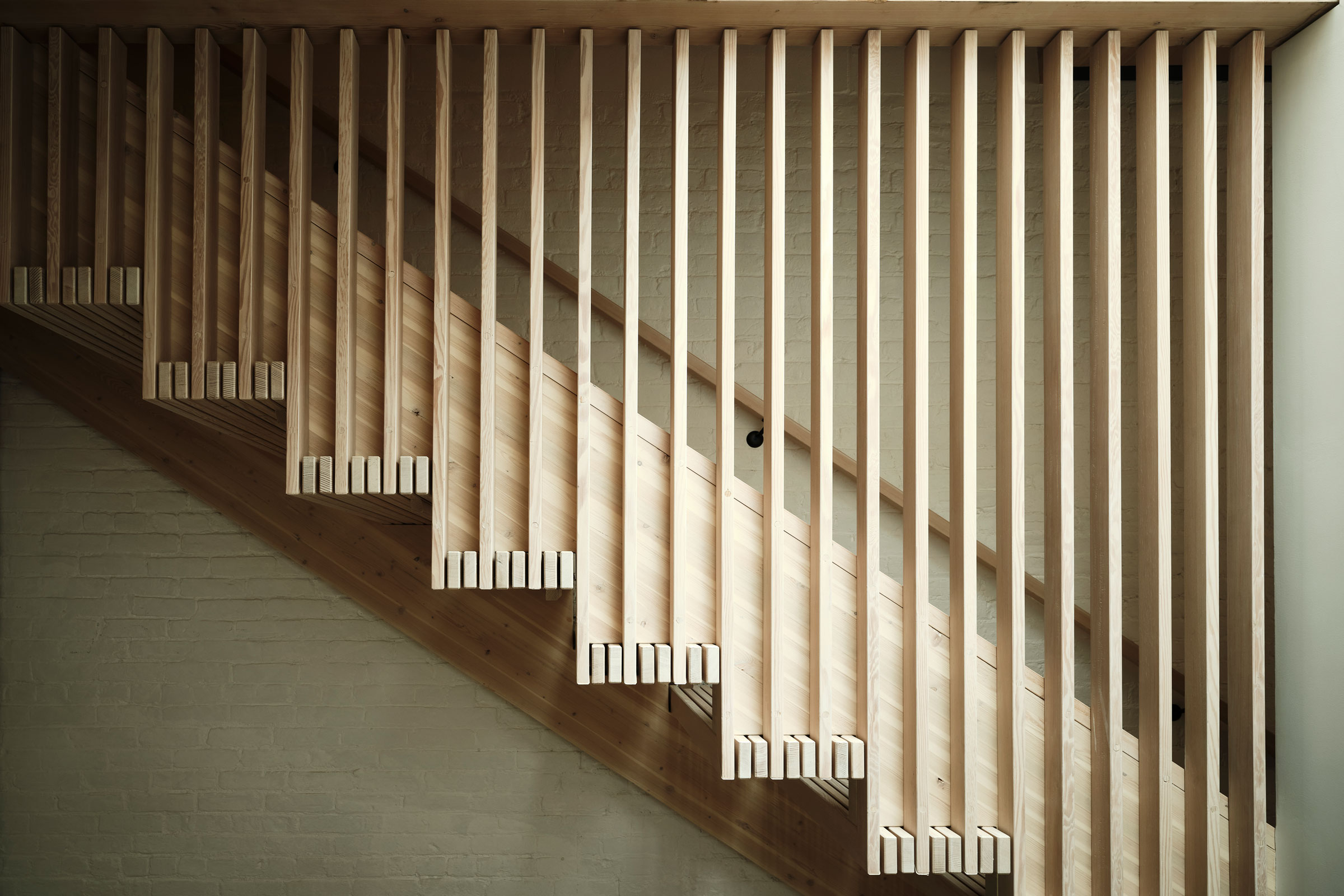
Glue-laminated Douglas fir forms the central stairwell that connects the three floors of Aaron Schiller’s Brooklyn Mass Timber House. Photo by Frank Frances
Renowned for its excellent strength and durability, Douglas fir is an incredibly versatile softwood that can be used for structural, load-bearing elements like beams and trusses as well as non-structural elements like furniture, millwork, and cabinetry. Douglas fir is inherently resistant to fungal decay, insect infestation, and moisture damage, allowing it to be used for a variety of exterior applications.
Because Douglas fir is considered to be one of the most resilient softwoods on the market, it is also ideal for use in mass timber applications. Aaron Schiller’s Brooklyn Mass Timber House, for example, makes heavy use of glue-laminated Douglas fir throughout, boasting a staircase made almost entirely from the material, whereas the BuildingWork-designed Swinomish Public Library in Washington incorporates a large amount of Douglas fir in the form of exposed CLT.
“We let the mass timber be what it is—the structural element of the whole building and also the interior finish,” Matt Aalfs, founder and principal architect of BuildingWork, previously told gb&d.
Redwood
Redwood is one of the strongest natural building materials, and it’s a great fit for areas like decks, as it’s naturally resistant to insects and decay. It does not warp and split easily, and it stays comfortable beneath your feet on a deck on a hot day.
Redwood is also a great alternative to plastic decking from a sustainability perspective.
Save the Redwoods League supports selective harvesting on previously cut-over lands and says such harvesting can prevent forest conversion to non-forest uses and lessen the impacts of climate change. Redwood can be purchased with an FSC label, indicating Forest Stewardship Council certification and ensuring products come from responsibly managed forests that provide environmental, social, and economic benefits. Conversely, plastic decking products often produce pollution as a byproduct and can end up in landfills whereas redwood can be recycled throughout its useful life.
Western Red Cedar
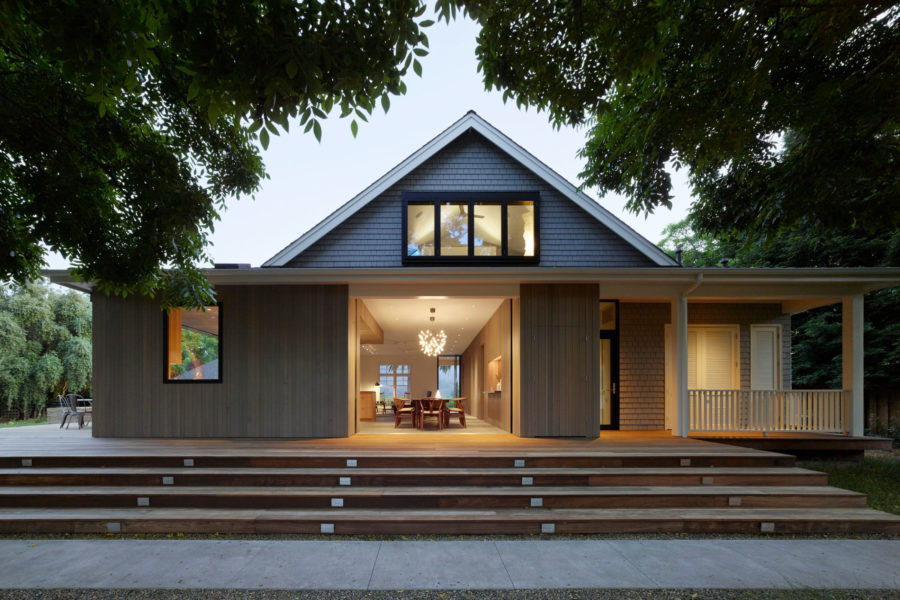
Cedar siding used throughout the renovated portions of the project defines the interventions and accentuates the traditional gray-painted cedar shake of the former design. Photo by Matthew Millman
Architects are increasingly turning to western red cedar for beautiful, sustainable projects. Also naturally rot resistant, it’s one of the widest spread growth ranges on the West Coast and can be finished in a variety of ways. You can even add pigment if you want.
“We like cedar because it brings a warmth, a softness to what are otherwise pretty modern buildings, and we like making these homes more livable and comfortable to be in,” says Greg Mottola, BCJ’s lead principal on both a Los Altos modern ranch project and a beautiful farmhouse in Calistoga.
WRC’s large, open cell structure makes the wood less dense than most other softwoods, so it’s also easier to move from place to place on the job. The versatility of WRC is one of the primary reasons it has been used for appearance and outdoor living applications for centuries.
Its open cell structure also helps to block noise. As an interior paneling or exterior siding, WRC’s low density makes it an acoustical barrier of much greater quality than many products marketed for those applications.
Eastern White Pine
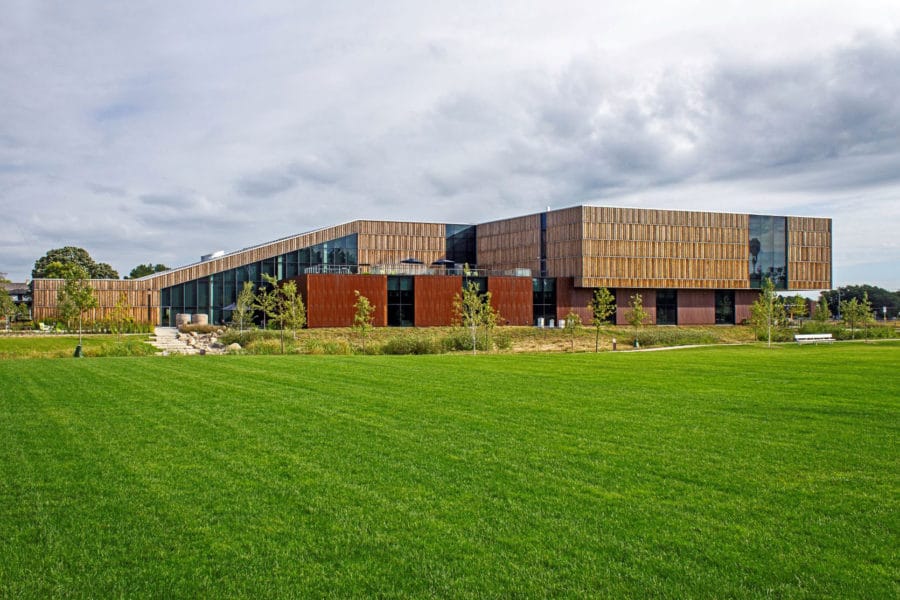
The award-winning Bell Museum of Natural History on the University of Minnesota campus incorporated more than 21,000 square feet of Arbor Wood thermally modified white pine for its facade. Photo courtesy of Arbor Wood
Eastern White Pine is found in heavy timber frame construction all over the world. Its softness makes it easy to work with, but it’s quite strong for its weight and doesn’t have the tendency to twist as much as some hardwoods do, according to the Northeastern Lumber Manufacturers Association (NeLMA). Because it grows so tall, you can also easily find Eastern White Pine timber that spans as much as 20 feet across.
NeLMA says the species also doesn’t shrink as much as many others when properly treated, and it has a strong cross-grain fiber that prevents it from checking too much.
More than 20,000 square feet of thermally modified white pine was used at the award-winning Bell Museum of Natural History on the University of Minnesota campus. The wood came from a forest located just 30 minutes away from the building site, according to Arbor Wood. Jon Heyesen says the project was intended to showcase the region’s natural history and called for a natural wood facade that was produced domestically, FSC-certified, installed without the need for finish or stain, and would last 25-plus years.
Minnesota-sourced white pine was harvested, thermally modified, and milled to meet this requirement and was the largest commercial installation of white pine cladding in the country. Thermally modified wood is defined as a natural wood product that has undergone some chemical changes using heat and steam to improve durability and stability. It can be used inside and out, and architects are increasingly turning to thermally modified wood for its many benefits.
Laura Rote contributed to this article.

